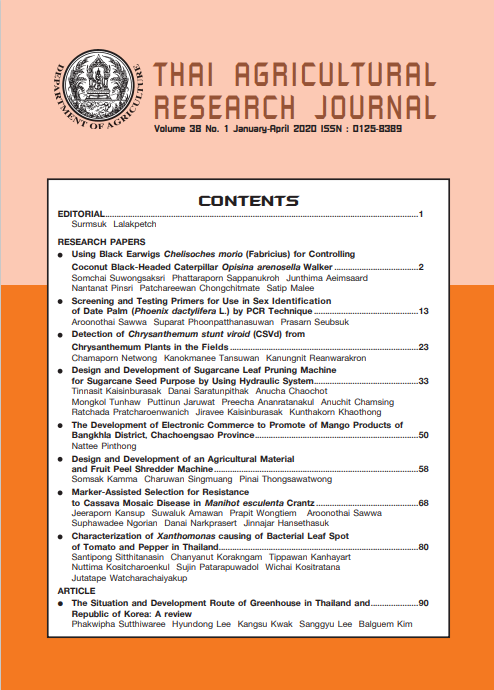Using Black Earwigs Chelisoches morio (Fabricius) for Controlling Coconut Black-Headed Caterpillar Opisina arenosella Walker
DOI:
https://doi.org/10.14456/thaidoa-agres.2020.25Keywords:
black earwig, coconut black-headed caterpillar, biologyAbstract
The Study of black earwig Chelisoches morio Fabricius usage to control coconut black head caterpillars Opisina arenosella Walker conducted at the Laboratory of natural enemies research and development building. Plant protection research and development office, Department of Agriculture and in aromatic coconut field crop at Samut Sakhon province and Karnchanaburi province between October 2016 - July 2018, the results were as follows; Black earwig can feed on pet foods such as cat food. Including eggs and other types of larvae as well. It is convenient and easy to rear in large quantities.. A biological study on Black earwig with cat feed was then conducted and revealed that female adult is usually laid egg in eggmass. The incubation period was 6.41 days. The duration of nymphal stage has four instars. The total nymph period was 40.12 days. The longevity of female and male were 102.65 and 91.20 days, respectively. Thus, the total life cycle of black earwig was 153.28 days. Result from study on feeding capacity of black earwig using all stage of black head carterpilla as food revealed that both female and male earwig can cosume evey stage of black head carterpillar with not significantly different but female earwig can consume much more than male earwig which significantly different with 36.40 and 31.60 larvae respectively.
With regards to the field trial study, the results revealed that releasing 8 black earwigs per plant and can be re-treated at the 3rd week. This strategy could be used in moderate outbreaks cases. However, the number of black earwigs should be released by up to 32 individuals per plant in order to control the severe outbreaks of coconut black head caterpillar. This strategy can be used to control the outbreaks up to 3 weeks.
References
พิมลพร นันทะ. 2544. การควบคุมแมลงศัตรูพืชโดยชีววิธี. หน้า 1-42. ใน: การควบคุมศัตรูพืชโดยชีววิธีเพื่อการเกษตรที่ยั่งยืน. เอกสารวิชาการ กลุ่มงานวิจัยการปราบศัตรูพืชทางชีวภาพ กองกีฏและสัตววิทยา กรมวิชาการเกษตร.
วิริยา ประจิมพันธุ์. 2550. การศึกษานิเวศวิทยาของแมลงดำหนามมะพร้าว Brontispa longissima
Gestro และทดสอบประสิทธิภาพการห้ำของแมลงหางหนีบ Chelisoches morio Fabricius. ;วิทยานิพนธ์, บัณฑิตวิทยาลัย มหาวิทยาลัยเกษตรศาสตร์.
สำนักวิจัยพัฒนาการอารักขาพืช. 2559. การจัดการศัตรูมะพร้าว. เอกสารวิชาการ สำนักวิจัยพัฒนาการอารักขาพืช กรมวิชาการเกษตร, กรุงเทพฯ. 90 หน้า.
สมชัย สุวงศ์ศักดิ์ศรี. 2559. แมลงหางหนีบ: แมลงตัวเล็กกับภารกิจที่ยิ่งใหญ่. น.ส.พ.กสิกร ปีที่ 89 ฉบับที่ 5 กันยายน-ตุลาคม 2559. หน้า 52-57.
บรรพต ณ ป้อมเพชร. 2525. การควบคุมแมลงศัตรูพืชและวัชพืชโดยชีววิธี. ศูนย์วิจัยควบคุมศัตรูพืชโดย ชีวินทรีย์แห่งชาติ มหาวิทยาลัยเกษตรศาสตร์ สํานักงานคณะกรรมการวิจัยแห่งชาติ. 202 หน้า.
อัมพร วิโนทัย พัชรีวรรณ มณีสาคร และสุวัฒน์ พูลพาน. 2559. การเพาะเลี้ยงและใช้ประโยชน์จากแตนเบียนหนอนหัวดำมะพร้าว โกนิโอซัส นีแฟนติดีส (Goniozus nephantidis). สำนักวิจัยพัฒนาการอารักขาพืช กรมวิชาการเกษตร. 15 หน้า.
Marcela N. and Mario V. N. 2012. Biology of the black earwig, Chelisoches morio (Fabricius) (Chelisochidae, Dermaptera) Philipp Ent 24(2):122-136.
Philippine coconut authority. 2012. Coconut leaf beetle Brontispa longissima (Gestro). [Brochure] Philippine, Carlos B. Cariio: Author.
Downloads
Published
How to Cite
Issue
Section
License
Thai Agricultural Research Journal



